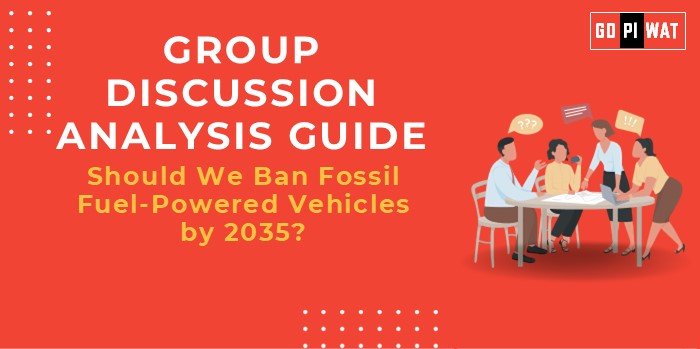📋 Group Discussion (GD) Analysis Guide
🚗 Should We Ban Fossil Fuel-Powered Vehicles by 2035?
🌟 Introduction to the Topic
Opening Context: Transitioning away from fossil fuel-powered vehicles is pivotal in combating climate change and reducing air pollution. Globally, countries are setting ambitious targets to phase out these vehicles, making this a crucial discussion for policymakers, businesses, and citizens alike.
Topic Background: The initiative to ban fossil fuel vehicles by 2035 aligns with global climate goals, such as the Paris Agreement, aiming to cap global warming below 1.5°C. Countries like Norway and the UK are leading this transition, while others weigh the implications on economies and societal structures.
📊 Quick Facts and Key Statistics
- 🌍 Transportation Emissions: Contributes to 25% of global CO₂ emissions.
- 🔋 EV Growth: Global EV sales doubled in 2021, reaching 6.6 million.
- 📉 Battery Costs: EV battery prices fell by 89% from 2010 to 2021.
- 🎯 Global Commitments: Over 30 countries pledged to end the sale of fossil fuel vehicles by 2040.
- 🇮🇳 India’s Target: Aims for 30% EV adoption by 2030, with state-specific EV policies in place.
👥 Stakeholders and Their Roles
- Governments: Set regulations, provide subsidies, and develop infrastructure for EVs.
- Automobile Manufacturers: Innovate and scale up EV production.
- Consumers: Shift preferences towards sustainable transportation.
- NGOs & Environmental Groups: Advocate for policies and create public awareness.
- Fossil Fuel Industry: Transition operations and investments to align with a green future.
🏆 Achievements and Challenges
🌟 Achievements:
- ⚡ Technological Advances: Improved EV battery efficiency and extended vehicle range.
- 💰 Economic Incentives: Subsidies have lowered EV costs, making them competitive.
- 🌍 Global Leadership: Norway achieved over 70% EV sales in 2021.
- 🌆 Urban Benefits: Cities like London saw a 30% reduction in NO₂ levels post-introduction of clean air zones.
⚠️ Challenges:
- 🔌 Infrastructure Deficit: Lack of widespread charging stations.
- ⛏️ Raw Material Constraints: Lithium and cobalt supply chain vulnerabilities.
- 🏭 Economic Impacts: Loss of jobs in traditional automotive sectors.
- 📊 Global Comparisons: The US EV adoption rate (7%) lags behind Europe (20%).
📑 Structured Arguments for Discussion
- Supporting Stance:
“Banning fossil fuel vehicles is essential to achieve net-zero emissions and mitigate climate change effectively.”
- Opposing Stance:
“The ban could disproportionately affect developing economies reliant on traditional vehicles.”
- Balanced Perspective:
“While necessary, a 2035 ban requires phased implementation, robust infrastructure, and equitable policies.”
✨ Effective Discussion Approaches
- Opening Approaches:
- 📊 Start with global data: “25% of global emissions come from transportation; a shift to EVs is non-negotiable.”
- 📚 Use a case study: “Norway’s 70% EV adoption shows what’s achievable with policy support.”
- Counter-Argument Handling:
- Acknowledge concerns on affordability and infrastructure, then present data-backed solutions like subsidies or PPP models.
🔍 Strategic Analysis of Strengths and Weaknesses
- 💡 Strengths: Reduced emissions, green jobs creation, alignment with global goals.
- ⚠️ Weaknesses: Economic strain on developing nations, technological dependency.
- 📈 Opportunities: Green energy integration, urban mobility innovation.
- 🌋 Threats: Geopolitical tensions over battery materials, lagging policy adoption.
🏫 Connecting with B-School Applications
- Real-World Applications:
- 🔄 Green supply chains in automotive production.
- 🌆 Sustainable urban planning for EV infrastructure.
- 💡 Innovation in mobility solutions, such as battery swapping models.
- Sample Interview Questions:
- “How can India accelerate EV adoption sustainably?”
- “What lessons can emerging economies learn from Norway’s EV model?”
- Insights for B-School Students:
- 📘 Focus on building sustainable business models.
- 🌍 Integrate policy analysis with market-driven solutions for EV adoption.


